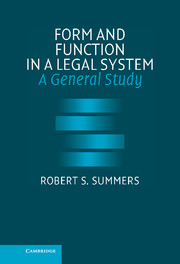Book contents
- Frontmatter
- Contents
- Preface
- Acknowledgments
- PART ONE INTRODUCTION, BASIC CONCEPTS AND DEFINITIONS, AND A GENERAL APPROACH
- 1 Introduction
- 2 Basic Concepts and Definitions
- 3 A General Approach
- PART TWO THE FORMS OF FUNCTIONAL LEGAL UNITS
- PART THREE THE OVERALL FORM OF A LEGAL SYSTEM AND ITS OPERATION
- Name Index
- Subject Index
2 - Basic Concepts and Definitions
Published online by Cambridge University Press: 29 July 2009
- Frontmatter
- Contents
- Preface
- Acknowledgments
- PART ONE INTRODUCTION, BASIC CONCEPTS AND DEFINITIONS, AND A GENERAL APPROACH
- 1 Introduction
- 2 Basic Concepts and Definitions
- 3 A General Approach
- PART TWO THE FORMS OF FUNCTIONAL LEGAL UNITS
- PART THREE THE OVERALL FORM OF A LEGAL SYSTEM AND ITS OPERATION
- Name Index
- Subject Index
Summary
“Those who are impatient with the forms of law ought to reflect that it is through form that all organization is reached. Matter without form is chaos; power without form is anarchy.”
– Bleckley, J.INTRODUCTION
This chapter opens with a general account of, and rationale for, the selection of functional legal units to be treated in this book. Thereafter I develop and refine my general definition of the overall form of any such unit as the purposive systematic arrangement of the makeup, unity, instrumental capacity, distinct identity, and other attributes of that unit. I then set forth the justifications for adopting this general definition of form.
Next, I turn to the varied types of general purposes that determine the systematic arrangement of any functional legal unit. I then clarify the main difference between the overall form and constituent formal features of a legal unit and the complementary material or other components of that unit. I also explain why I have not adopted the perhaps more familiar “form v. substance” contrast as central. Along the way, I explain how my uses of “form” and “formal” are similar to, or different from, certain ordinary uses of these words in English and also similar to, or different from, certain technical uses of these words by legal theorists and other scholars.
A SELECTION OF FUNCTIONAL LEGAL UNITS AND THEIR OVERALL FORMS
As we have seen, a functional legal unit may be institutional in nature, such as a legislature, or preceptual, such as a statutory rule, or a nonpreceptual species of law, such as a contract, or a methodological unit, such as an interpretive methodology for statutes, or an enforcive unit, such as a sanction of imprisonment.
- Type
- Chapter
- Information
- Form and Function in a Legal SystemA General Study, pp. 37 - 63Publisher: Cambridge University PressPrint publication year: 2005

